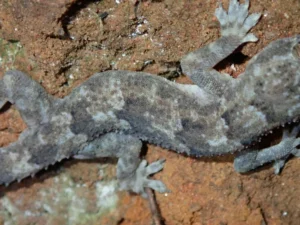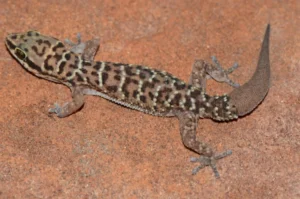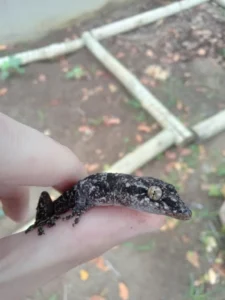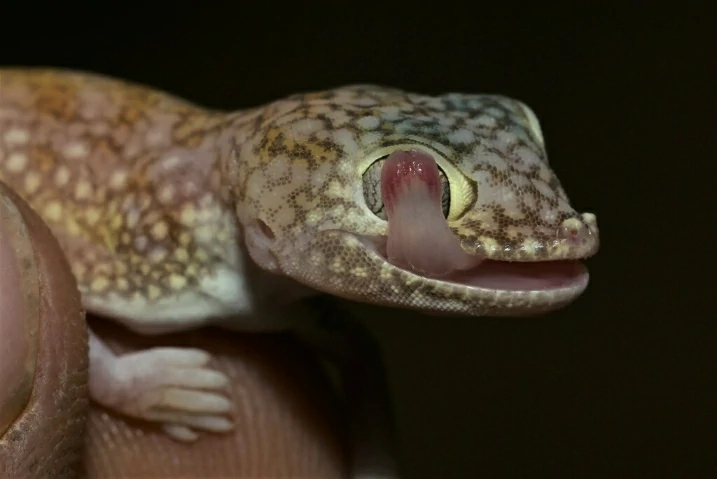If you’ve ever misted your gecko’s tank or watched it walk through shallow water, you might’ve wondered if geckos can soak up water through their skin.
Frogs do this all the time, and since geckos need humidity, it seems like a fair question. So, do geckos absorb water through their skin?
Geckos can take up only very small amounts of water through their skin. They get most of their water by drinking and from their food. Gecko skin is thick and scaly, so it doesn’t soak up water the way a frog’s skin does. The tiny bit of water that might get through happens in thin areas, like around the vent, but it’s very small.
Even with that tiny help, geckos still need drinking water. Skin absorption alone won’t keep them hydrated.
How Gecko Skin Works
To see why geckos don’t absorb much water, you need to look at their skin. It’s covered in scales made of keratin, the same stuff your fingernails and hair are made of.

The scales overlap and make a strong barrier that keeps water in, not out.
Geckos evolved in places where holding onto water was more important than soaking it up. Water just beads and rolls off their skin.
Frogs, on the other hand, have thin, wet skin that soaks up water easily.
Some frogs get most of their water just by sitting in a puddle or on wet leaves. Some hardly drink at all.
Gecko skin has a different job. It keeps them from drying out in hot or dry places.
Where Geckos Can Take in Water
Most of a gecko’s skin doesn’t soak up water, but a few spots can take in tiny amounts. The skin between scales is a little thinner and flexible, so a bit of water can sneak through.
Some lizards can also take in a little water at the cloaca (vent), which is the opening they use to get rid of waste or lay eggs.

Some studies show this can happen, but for most pet geckos, it’s very small.
The skin on their belly is also thinner than the back or sides. So when a gecko walks through shallow water or sits on damp surfaces, it might absorb a tiny bit.
Even in these spots, it’s just a drop compared to what they need. Geckos still need to drink water to stay healthy.
How Geckos Stay Hydrated
The main way geckos stay hydrated is by drinking. They lap water up with their tongues from dishes, droplets on glass, or puddles in the wild.
Some geckos like moving water or droplets more than still water.
That’s why misting is so important for species like crested geckos, they like licking droplets off leaves and glass.
Geckos also get water from food. Insects have moisture in them, so when geckos eat bugs, they’re getting water along with food.
Feeding insects that have been gut-loaded with veggies gives extra moisture.
Humidity around them slows water loss through their skin and breathing, but it doesn’t directly hydrate them.
High humidity just helps them keep the water they’ve already drunk.
Why Humidity Matters
Even though geckos don’t soak up much water, humidity is still really important. It helps in a few ways:
-
It slows water loss. In dry conditions, geckos lose water through their skin and when they breathe. Good humidity helps them keep the water they drink.
-
It helps with shedding. Geckos need moisture to shed properly. Low humidity can cause stuck skin, especially on toes and tails, which can lead to health problems.
Tropical geckos like crested geckos need around 60–80% humidity, while desert geckos like leopard geckos do better with 30–40%.
The right humidity depends on species and age. Desert geckos usually need low humidity overall but a moist hide to help with shedding.
Signs Your Gecko Needs More Water
Even if water is available, your gecko might not be drinking enough. Signs include:
-
Sunken eyes: eyes look hollow instead of round and full.
-
Wrinkled or loose skin: hydrated geckos have smooth, tight skin. Saggy skin, especially around the neck or sides, means they need more water.
-
Stuck shed: old skin should peel off in a few pieces, not stick in small bits.
-
Loss of appetite: dehydration can stress their bodies and make them stop eating.
Can Geckos Get Too Much Water Through Skin?
Not really. Geckos can’t absorb enough through their skin to over-hydrate. Sitting in a dish or walking through shallow water won’t hurt them.

Soaking them completely in water is bad, though. It stresses them and can even cause drowning. The danger is stress, not too much water.
Some people do shallow soaks to help with stuck shed or constipation. If you do this, only put water deep enough to reach the belly, never deeper.
Keep it warm and supervise. Vets usually say 10–20 minutes is enough.
Too much humidity can also cause problems, like respiratory or skin infections, especially for desert species.
Different Species, Different Needs
Some geckos might take in a tiny bit of water through skin more than others, but all geckos still need to drink.
Tropical species like crested, gargoyle, and day geckos live in humid areas and might get slightly more moisture through skin, but they still drink.
Desert geckos like leopard geckos or African fat-tailed geckos keep water very well, so they don’t soak much through skin.
Some species get most of their water from insects and rarely drink. Even they still need humidity and will drink if water is around.
No matter what species, always provide a water dish and keep the right humidity.
The Role of Misting
Misting has several jobs, but it’s not mainly for hydrating through skin:
-
It raises humidity and slows water loss.
-
Drops give geckos something to drink. Many prefer droplets over a dish.
-
It helps with shedding by keeping the air moist.
-
For tropical species, misting recreates daily rain or dew they’d see in the wild.
What About Stuck Shed?
If your gecko has stuck skin, adding humidity or a shallow soak helps, but it’s not hydrating them through skin.
Moisture softens the stuck skin from the outside so it can come off.
Shallow soaks work the same way. Think of it like soaking a dried sponge, it softens from the outside, not the inside.
Focus on keeping proper humidity to prevent stuck shed.
How to Keep Your Gecko Hydrated
The easiest way: clean water and the right humidity.
-
Shallow water dish in the tank that your gecko can reach. Change water daily.
-
Mist as needed: tropical species may need it twice a day; desert species may only need a light mist every few days.
-
Feed well-hydrated insects, gut-loaded with veggies.
-
Check humidity with a hygrometer. Don’t guess.
-
Watch for dehydration and adjust care. Every gecko is a little different.
Common Mistakes
-
Thinking humidity alone hydrates a gecko. It slows water loss, but they still need to drink.
-
Assuming misting replaces a water dish. Even geckos that like droplets need water they can drink.
-
Believing baths hydrate better than drinking. Drinking is safer and works better.
-
Forgetting water in food. Insects contribute to hydration.
-
Assuming all geckos need the same care. Desert and tropical species are very different.
Conclusion
Geckos can take in very tiny amounts of water through skin, but they mostly rely on drinking and moisture from food. Vent (cloacal) uptake is very small and species-dependent.
They stay hydrated by drinking water and eating insects. Humidity helps slow water loss and makes shedding easier, not by soaking them through skin.
To keep your gecko healthy, give clean water, keep proper humidity for its species, feed moisture-rich insects, and watch for dehydration signs like sunken eyes or wrinkled skin.
Hi, my name is Ezra Mushala, i have been interested animals all my life. I am the main author and editor here at snakeinformer.com.

